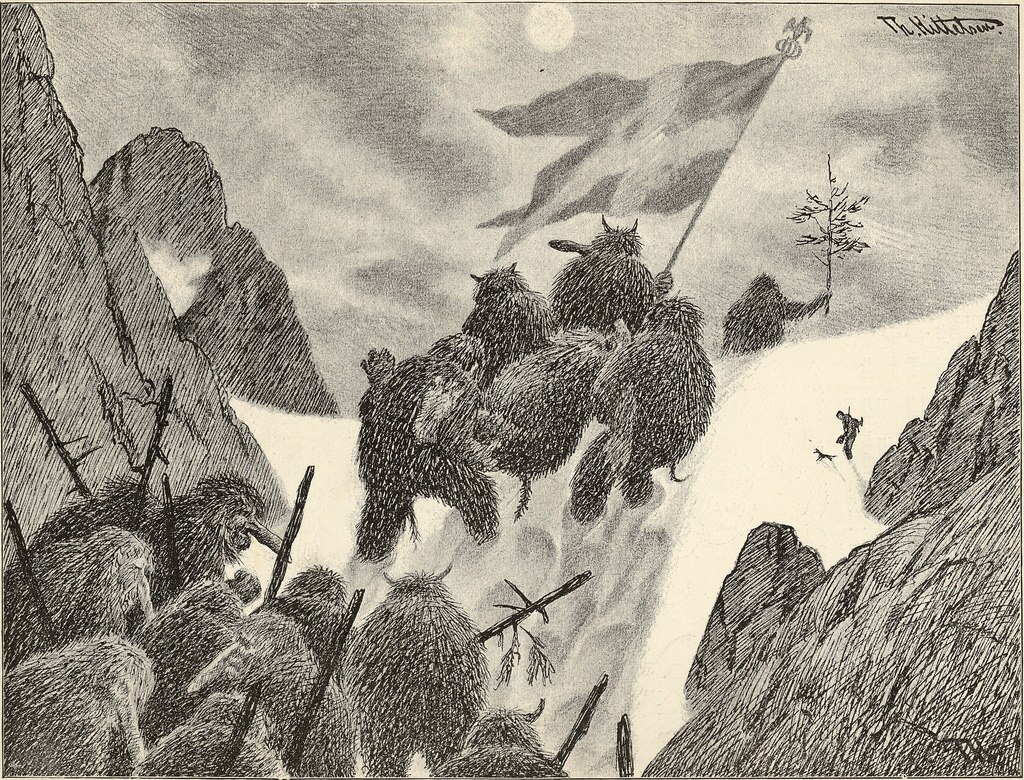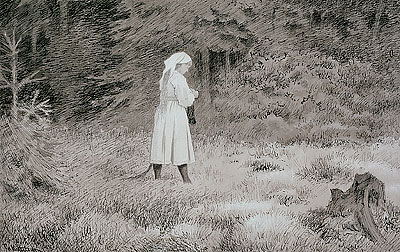Most of these creatures are sentient and not designed to be fought. The statblocks are created for Old School Essensials, and therefore compatible with other OSR products. I prefer ascending AC, and have not included the treasure statline.
All of the artwork in this post is done by the famous Norwegian artist Theodor Kittelsen.
Bearmen
Bearmen is my take on Bugbears, with a folklore flavor.
Infants left in the woods are sometimes found by creatures of the dark (1). The child will change into a new type of creature. They will grow thick pelt, long horns and claws, and a bear-like snout. These creatures are often dubbed ‘Bearmen’ by ignorant villagers.
Bearmen often live in forests, and keep to themselves. They seldom interact with humans, but when they do so with great skepticism. They remember their past and the tales from their foster parents. These tales seldom have positive things to say about humans.
HD 2 (8), AC 13, Atk 1 x +1 (1d8), Saves D12 W13 P14 B15 S16, Morale 6, Alignment Neutral, Number appearing 1d6
Plot hook: Rumors of strange bipedal beasts in the forest nearby strike fear into the hearts of farmers. A reward is given to the ones who get rid of these beasts. Meanwhile, some of the farmers are leaving unwanted children out in the forest, by advice from an old hag.
- The dark here refers to a type of underworld that is separate from that of hell or undeath. It is the dark places in forests, under old roots, in cracks in mountains, and deep down in lakes and swamps.
Huldra
A hulder is a type of forest spirit - a creature of mystery. A hulder is sometimes a temptress, and sometimes a friendly helper to those in the forest. If given food or protection, a hulder can form a strong bond with a human. A hulder is very shy if approached by a group. If approached by a single human however, they become more open (and dangerous).
They are often disguised as young men or women. However, no matter what form they take, their furry tail is always visible from beneath their dress or pants. Hulders enjoy playing fiddle in wild places - for example at the top of waterfalls, at the forest floor of a particularly dark forest, or in the deepest fjord in a stormy night.
The female hulder is simply called hulder. A male version is called huldrekall.
HD 3 (12), AC 14, Atk 1 x +1 (charm), Saves D10 W11 P12 B13 S14, Morale 6, Alignment Neutral, Number appearing 1
- Charm: The hulder tries to charm a target, often through a beautiful song or playing a fiddle. Target must save vs spells. If they fail, they wander toward the hulder. The hulder often commands them to throw themselves off dangerous heights.
Plot hook: During the storm last night, many farmers heard a strange song from the fields. The song seemed to sing along with the rain and thunder. Now, the morning after, a farmer's son is missing.
Neck
The Neck is a shapeshifting water-based type of creature. They live in lakes deep within the forest. Like the hulder, they can both be evil and kind. Unlike the hulder, the neck almost always appears as a hideous creature. They look like weeds and mud, with a pair of glowing yellow or blue eyes. They often lurk just beneath the surface, and burst out to pull unsuspecting people underneath the waters. It will then devour them whole. A neck will avoid open combat at any cost, and only attack lone targets.
It is rumored that a neck can never be killed, unless their true name is spoken. However, acquiring their true name is very difficult since the neck will be very careful to whom it divulges its name.
HD -, AC 13, Atk 1 x +2 (drown), Saves D10 W11 P12 B13 S14, Morale 9, Alignment Neutral, Number appearing 1
- Drown: The neck attempts to pull the target down beneath the waters. The target must save vs death or begin to drown. In 3 rounds, the neck devours them whole.
Plot hook: A wandering priest tells a tall tale of a strange white horse in the forest. The horse spellbound him, and led him to a small lake. It was only due to the mercy of God that the priest managed to break the spell. Now the priest wants someone to chase the horse away!
Draugr
The draugr is the only undead creature on this list. They are people who have died and then returned in undeath. To avoid the typical zombie, I will focus on the mariner aspect of the draugr. This version of the draugr is most common on the west coast of Norway - and most known to me.
A draugr of the sea is created when a mariner is drowned by another mariner, or the mariner has promises unkept. This vengeance or promise will keep them from reaching the afterlife. The draugr will haunt their killers or the ones whom they have promises with, until they can be release.
A draugr wears the clothes they did in life, but their hair is replaced by seaweeds and their teeth have grown pointy and sharp.
HD 4 (18), AC 15, Atk +4 (claws 2d6), Saves D10 W11 P12 B13 S14, Morale 8, Alignment Evil, Number appearing 1d4
Plot hook: Seven years ago, Magnus asked Frida for her hand in marriage. Being sly and cruel, Frida agreed to marry him on one condition: he must bring her droplets from the deepest whirlpool. Magnus, being madly in love and perhaps a bit dumb, agreed and set sail. Frida quickly forgot about him, but after seven years she started to see a strange man lurking in the edge of her vision. She seeks help to rid her of the curse.
Trolls
There are many types of trolls in Scandinavian folklore. Some are beast-like, others are more like a traditional giant. The most common type of troll, often found in fairy tales, is somewhere in between a beast and a giant. They often have thick, shaggy fur, and long and thick noses. Sometimes they have multiple heads. Trolls are a distant cousin of the Jotun (giants and enemies to the norse gods).Some trolls live under bridges, others in deep forests. Common is that all trolls cannot survive in the sunlight. If exposed to sunlight, they start to calcify and turn to stone. They also have an excellent sense of smell, and can smell if any religious persons are close by.
Raglefant
Raglefants (rag-leh-fant) are often found in forests, and especially under bridges. They will want pay from anyone crossing a bridge they “own”. A raglefant is quite dumb.
HD 8 (36 hp), AC 12, Atk 2 x +4 (1d8 fists), Saves D8 W9 P10 B10 S12, Morale 8, Alignment Neutral, Number 1
Plot hook: A fat troll has taken residence underneath a bridge connecting the village to the mountain where their sheep feed. The villagers need to collect the sheep soon, but are afraid to cross the bridge.
Tusseladd
The wildest of the trolls. Tusseladds (tuss-eh-lad) wander over great distances and cause absolute mayhem. They often have multiple heads, which increase their wildness.
Roll a d6: 1 = 1 head, 2-3 = 2 heads, 4-5 = 3 heads, 6 = 4 heads (chaos!).
HD 6 (27 hp), AC 13, Atk 2 x +6 (1d10 fists), Saves D10 W11 P12 B13 S14, Morale 9, Alignment Neutral, Number 1
Plot hook: A trail of uprooted trees and boulders tossed afar leave the forest in chaos. A woodcutting expedition was abruptly disrupted by this burst of chaos during the night. Vital equipment was destroyed, and the horses stolen. The lumberjacks want their horses back, and are willing to pay handsomely.
Dovregubbe
The slowest and laziest of the trolls. A dovregubbe (dov-reh-gub-eh) lives in deep
caves, and enjoy porridge and eating competitions. A dovregubbe hates
religion, and will hunt down any religious humans that enter its
domain.
HD 5 (22 hp), AC 14, Atk 1 x +4 (1d12 fist), Saves D8 W9 P10 B10 S12, Morale 8, Alignment Neutral, Number 1d4 (each female will have 12 children)
Plot hook: A small village suddenly got their church crushed by a large boulder during their sermon last Sunday. Many were hurt, and some even died. Now the villagers are out for revenge on the monster that did this.



.jpg)



Oh these will come in handy! I've been working on a campaign with a major viking presence and some Norse monsters should fit nicely.
ReplyDeleteGlad to hear that! Good luck on your campaign
Delete